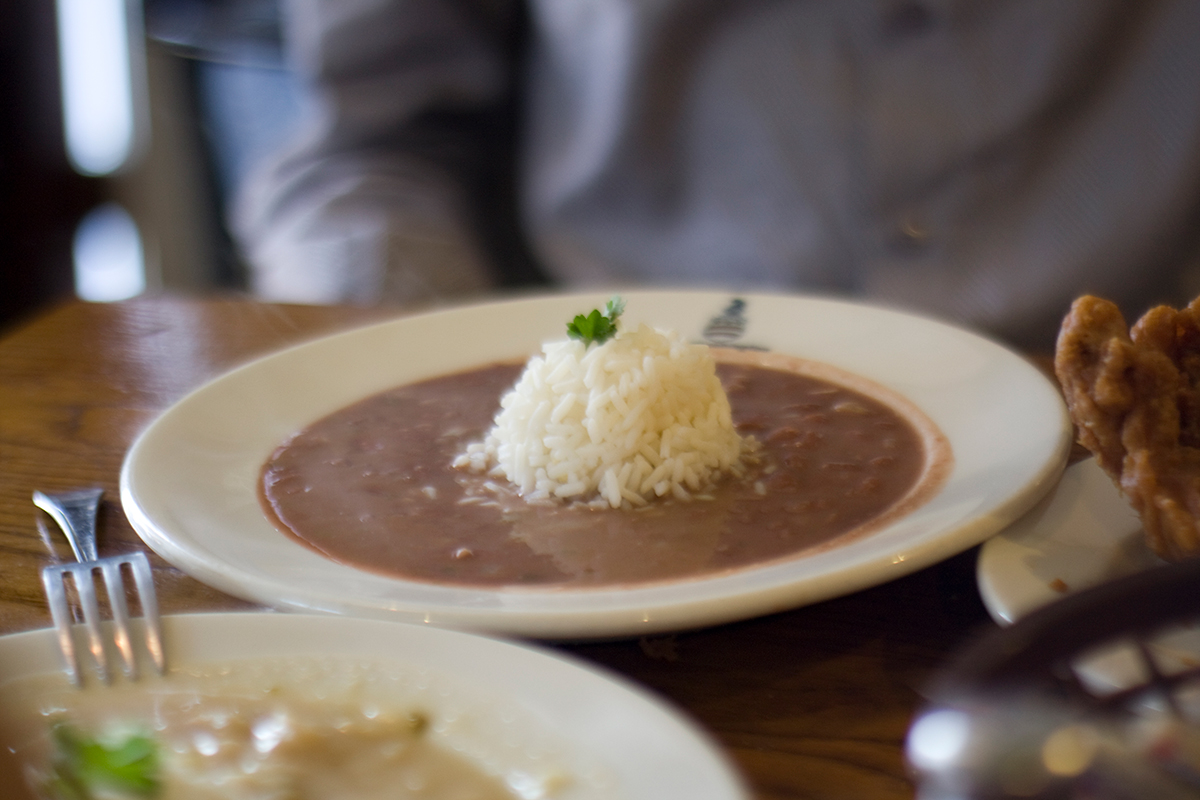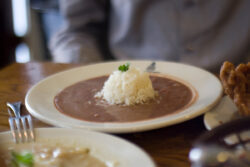Red Beans and Rice
Traditionally served on Mondays in New Orleans, red beans and rice is an economical dish that has become a staple throughout Louisiana and the Gulf Coast.

Kent Wang via Wikimedia Commons
A plate of red beans and rice at Willie Mae's Scotch House in New Orleans, 2009.
Red beans and rice is a beloved meal served in households across New Orleans. Made with inexpensive ingredients and simple instructions, its popularity has also spread across Louisiana and the Gulf Coast.
Culinary writers and many home cooks designate Monday as the traditional day for making red beans and rice. On Sunday evenings, household cooks would place their beans in water to soak overnight. They would save slivers of ham and the ham bone from Sunday’s midday dinner and use that to season the beans on Monday morning. While they washed clothes on this traditional day for laundry, the beans would cook on the stove. If no ham was available, bacon drippings and salted or seasoning meats could be used instead. Always added were onions, green peppers, and celery, though other ingredients were possible as well. Cooks could add garlic, chicken broth or stock, ham hock, pickled pork, bay leaf, thyme, hot sauce, or whatever they had on hand. The recipe allows significant variations, and even vegetarian and vegan recipes are not complicated. The beans cook for one to two hours or until soft. At the end of cooking, some of the beans can be made creamy by mashing them to the pot’s side or removing two or three cups to be pulverized in a blender. Rice, of course, can be made at the last minute or earlier.
Today the routine may be different, and containers of beans may be frozen for use on future Monday evenings or any time one has an unexpected crowd or a neighborhood party. Restaurants also serve red beans and rice, cooking early for the lunch crowds on Mondays.
The red kidney beans used for the dish are a variety of Phaseolus vulgaris, the common bean originating in Central America. Camellia Brand, Trappey’s, and Blue Runner are Louisiana-based companies that package red beans and sell them in bags or cans. Today the leading growers are in Minnesota, Michigan, Colorado, and New York.
Many cultures make use of beans (the seeds of the legume) in a similar slow-cooking manner, some with rice and some without. Examples include glandoulat and potée alsacienne from France, Moros y Cristianos from Spain and Cuba, gallo pinto from Nicaragua, peas and rice in the English-speaking Caribbean. From 1791 through 1810, refugees fleeing the revolution in Saint-Domingue, now Haiti, brought diri kolé ak pwa to New Orleans, and the dish, flavored with a green seasoning mix of parsley, garlic, and other herbs, remains a comfort food placed among Haitian national dishes today.
Antoine Le Moyne de Châteauguay, brother to explorers Iberville and Bienville, was said to have brought the first rice to Louisiana from Saint-Domingue in 1719. Plantation owners and colonial administrators asked traders en route to Africa to capture persons skilled in growing rice. Once in Louisiana, the enslaved laborers made rice flour, cooked and ate rice in various ways, enabled their enslavers to sell rice, and, in general, made it a part of the region’s diet. Colonial rulers required that rice be kept in supply for times of hunger. By the 1840s, small farmers also grew rice. For all producers, New Orleans warehouses near the port were critical, as were the coming of the railroads and the expertise of scientists hired to help maximize rice cultivation.
In 1900 Louisiana surpassed South Carolina in rice production and sales, and a host of new settlers in the area, from second- and third-generation Midwesterners to newly arrived Polish Jewish immigrants skilled in chemistry, nurtured the industry. But the original African influence remains primary. Even today, most Louisianans cook rice as their ancestors learned from eighteenth- and nineteenth-century enslaved people: with water alone, letting the rice absorb the liquid. Different methods, such as the coating of grains in oil or butter before adding wine and/or other liquids, are not as popular in Louisiana.
The second edition of The Picayune’s Creole Cook Book (1901) includes a whole chapter on rice dishes and several red bean recipes in the vegetable section. The cookbook includes a recipe for “Red Bean Soup,” which it suggests can be used during Lent (when meat was shunned), as well as other recipes that seem almost like today’s red beans and rice. The Picayune’s author and compiler, Marie Louise Points, states that red beans are “a favorite dish among Creole families . . . a food for growing children and adults who labor hard.” She also presents a recipe for “Red Beans, Burgundy Style/Haricots Rouges à la Bourguignonne.” This differs from today’s recipe because it calls for cloves stuck into an onion, a French convention. Another recipe, her “Red Beans and Rice/Haricots Rouges au Riz,” is also derived from the French in the addition of a carrot.
What is notable in the timeline of cookbooks is that recipes for red beans and rice are missing from The Creole Cookery Book and La Cuisine Creole (both 1885) and another early book, Cooking in Old Créole Days: La Cuisine Créole à l’Usage des Petits Ménages (1904). The ascent of red beans and rice to inscription in texts thus seems to have followed rice’s place in the state’s economy.
Cookbook writers, politicians, musicians, poets, and novelists have all evoked this humble meal as symbolic of a Louisiana way of life. The symbol of a bean is found in ratings of restaurants, in jewelry, and in Mardi Gras costumes. Louis Armstrong made the dish a centerpiece of his life. Returning to New Orleans, he often preferred eating his beloved dish at Sheep’s Restaurant on Dumaine Street near Claiborne, making that establishment well known to jazz lovers and other musicians. He occasionally signed his letters, “Red beans and ricely yours.” In the early 2000s, James Beard Foundation winner and Scotch House restaurant owner Willie Mae Seaton commented on the centrality of beans and rice to the city’s food. Even though she was best known for her fried chicken, she told memoirist Sara Roahen, “This is a red bean city here. That’s it. If you don’t have no red beans, you just out.”
